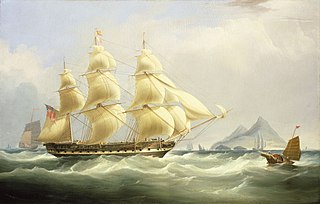Three ships named Ceres, for Ceres, the Roman goddess of agriculture, served the British East India Company (EIC) as East Indiamen:

In ancient Roman religion, Ceres was a goddess of agriculture, grain crops, fertility and motherly relationships. She was originally the central deity in Rome's so-called plebeian or Aventine Triad, then was paired with her daughter Proserpina in what Romans described as "the Greek rites of Ceres". Her seven-day April festival of Cerealia included the popular Ludi Ceriales. She was also honoured in the May lustratio of the fields at the Ambarvalia festival, at harvest-time, and during Roman marriages and funeral rites.

The East India Company (EIC), also known as the Honourable East India Company (HEIC) or the British East India Company and informally as John Company, Company Bahadur, or simply The Company, was an English and later British joint-stock company. It was formed to trade in the Indian Ocean region, initially with Mughal India and the East Indies, and later with Qing China. The company ended up seizing control over large parts of the Indian subcontinent, colonised parts of Southeast Asia, and colonised Hong Kong after a war with Qing China.
- Ceres (1773 EIC ship) was launched in 1773 and made four voyages before she was sold in 1784 as a hulk.
- Ceres (1787 EIC ship) was launched in 1787 and made three voyages before the British Royal Navy purchased her and renamed her HMS Grampus. Grampus stranded in 1799 in the Thames and had to be burnt.
- Ceres (1797 EIC ship) was launched in 1797 and made nine voyages for the EIC before she was sold in 1816 as a hulk.

Ceres was an East Indiaman launched in 1787. She made three trips to China for the British East India Company (EIC). After the outbreak of war with France in 1793, the Admiralty, desirous of quickly building up the Royal Navy, purchased a number of commercial vessels, including nine East Indiamen, to meet the need for small two-decker fourth rates to serve as convoy escorts. The Admiralty purchased Ceres in 1795 and renamed her HMS Grampus. In 1797 the Admiralty converted her to a storeship. That year her crew participated in the Spithead and Nore mutinies. Grampus grounded in January 1799 and was destroyed.

The Royal Navy (RN) is the United Kingdom's naval warfare force. Although warships were used by the English kings from the early medieval period, the first major maritime engagements were fought in the Hundred Years War against the Kingdom of France. The modern Royal Navy traces its origins to the early 16th century; the oldest of the UK's armed services, it is known as the Senior Service.

Ceres was launched in 1797 as an East Indiaman. She made nine voyages for the British East India Company (EIC), before she was hulked in 1816.
In addition, one vessel named Ceres performed two voyages for the EIC under charter.
Ceres was launched at Whitby in 1794. She made two voyages for the British East India Company (EIC). Thereafter she remained a London-based transport. She was last listed in 1816.
| This article includes a list of ships with the same or similar names. If an internal link for a specific ship led you here, you may wish to change the link to point directly to the intended ship article, if one exists. |
